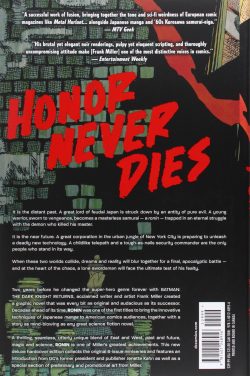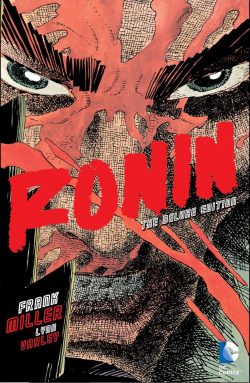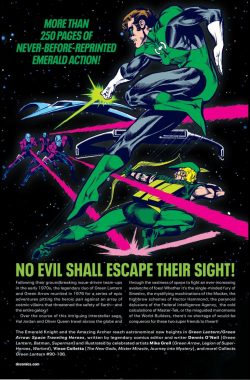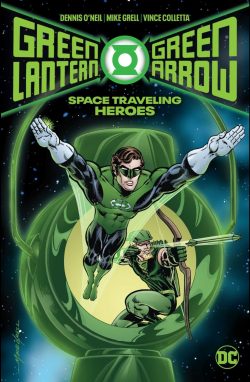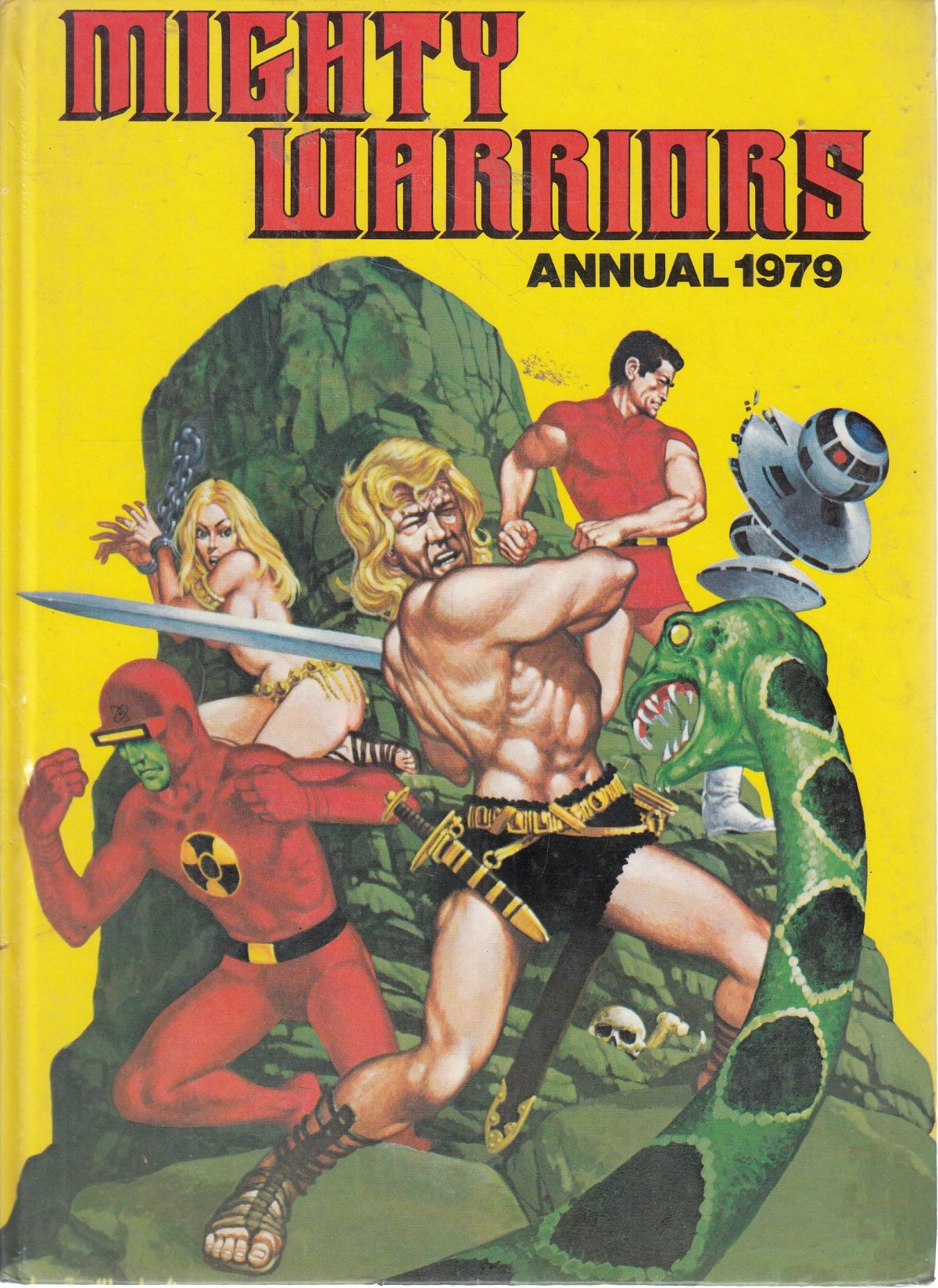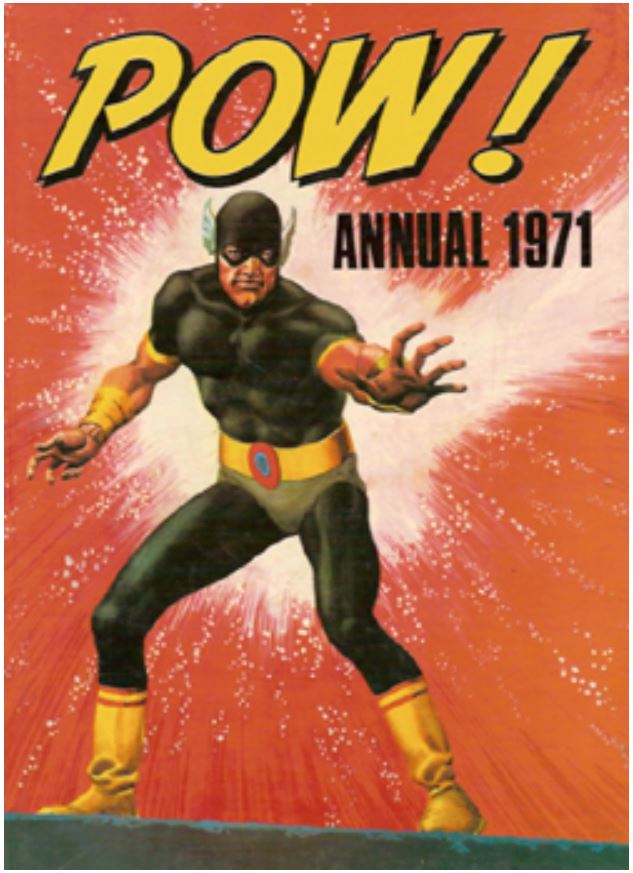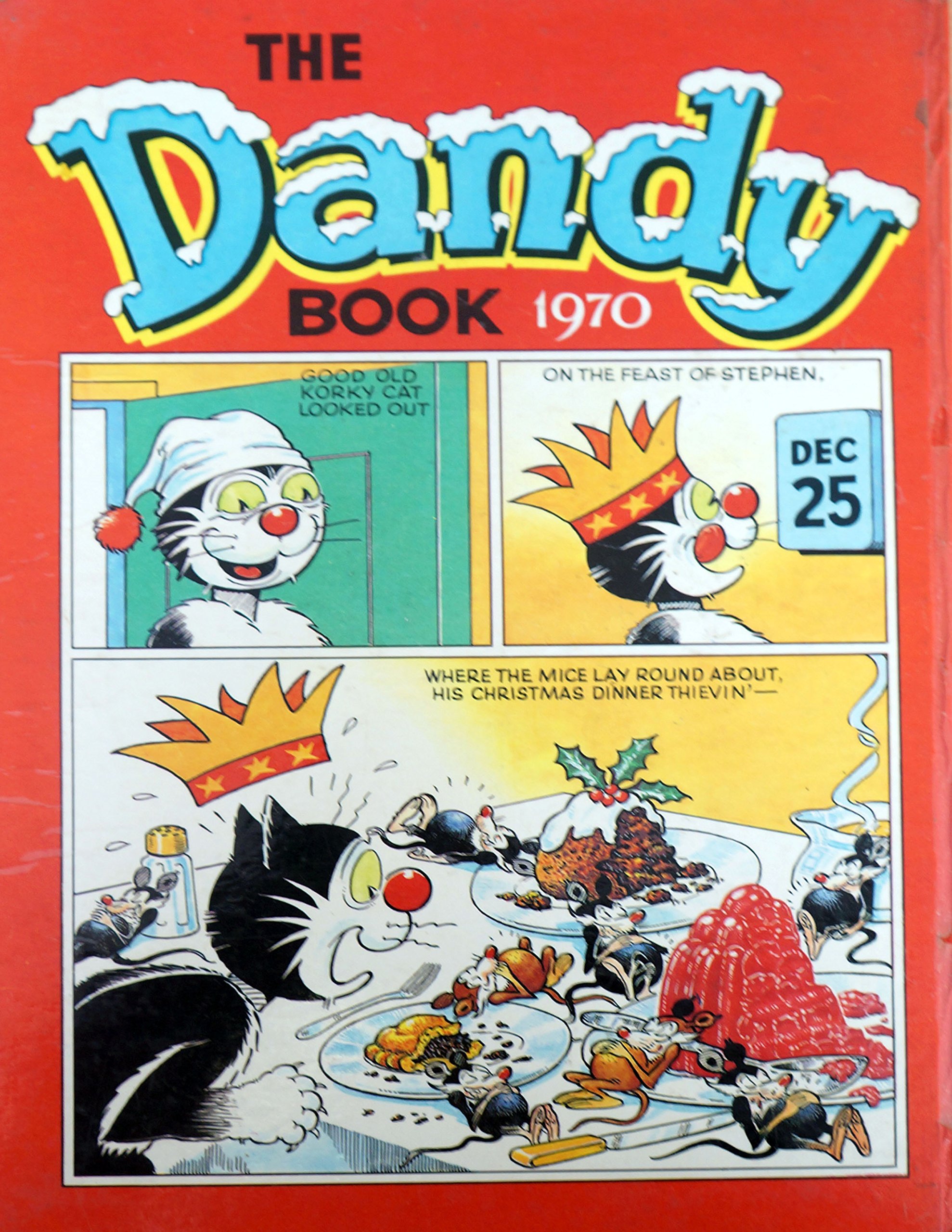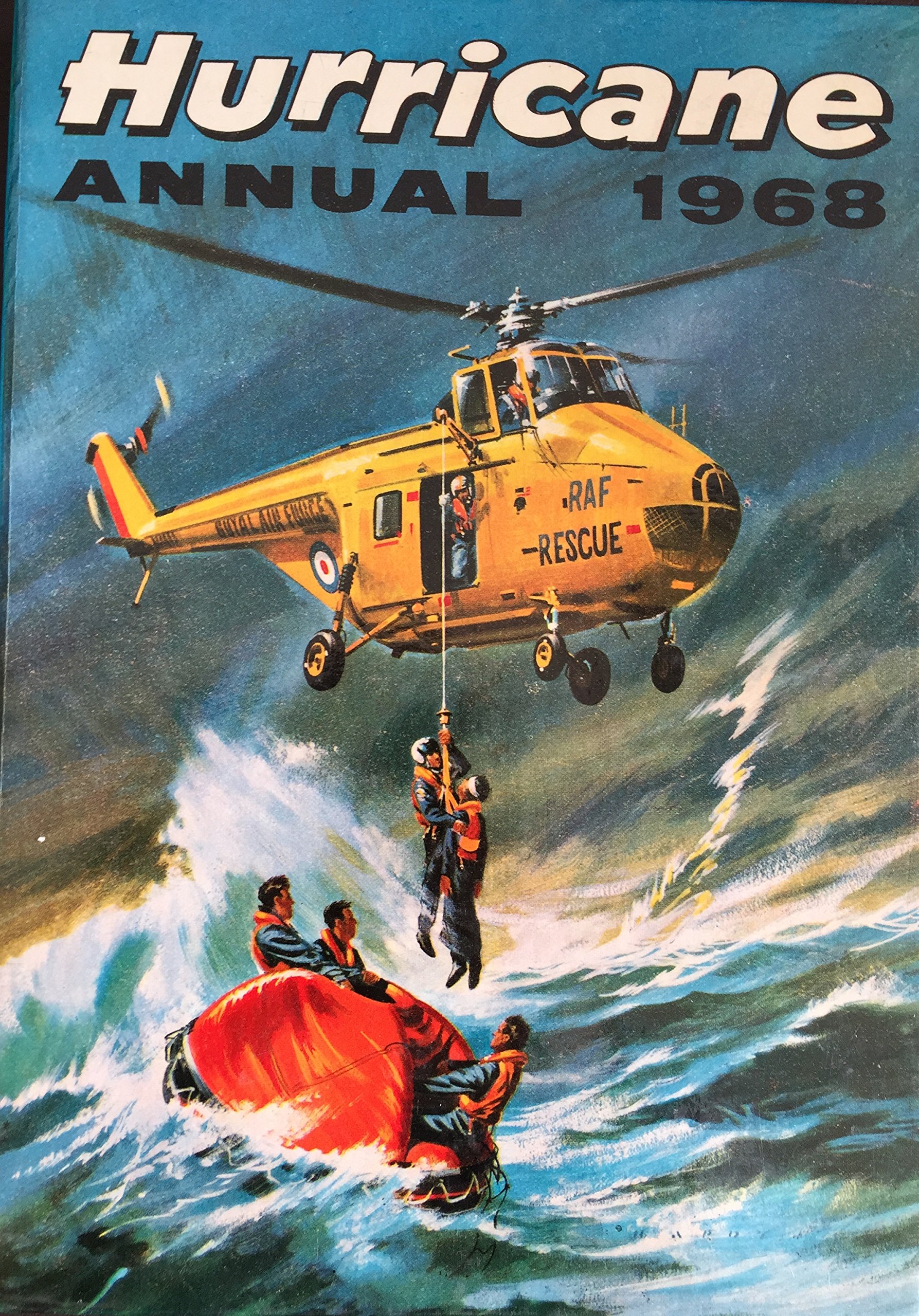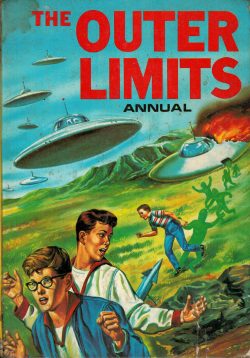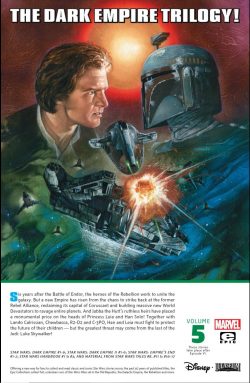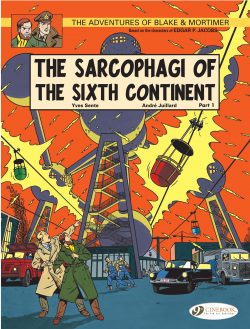
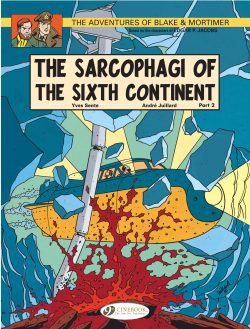
By Yves Sente & André Juillard, coloured by Madeleine DeMille & translated by Jerome Saincantin (Cinebook)
ISBN: 978-1-84918-067-2 (Album PB) 978-1-84918-077-1 (Album PB)
Win’s Christmas Gift Recommendation: Blockbuster Thrills No Movie Can Match… 9/10
Pre-eminent fantasy raconteur Edgar P. Jacobs devised one of the greatest heroic double acts in pulp fiction: pitting his distinguished scientific adventurers Professor Philip Mortimer and Captain Francis Blake against a daunting variety of perils and menaces in a sequence of stellar action-thrillers blending science fiction scope, detective mystery suspense and supernatural thrills. The magic was made perfect through his stunning illustrations, rendered in the timeless Ligne Claire style which had made intrepid boy-reporter Tintin a global sensation.
The Doughty Duo debuted on 26th September 1946: gracing the pages of the very first issue of Le Journal de Tintin: an ambitious international anthology comic with editions in Belgium, France and Holland. It was edited by Hergé, with his eponymous, world-famous star ably supplemented by a host of new heroes and features for the rapidly-changing post-war world. Bon anniversaire, Chaps!…
Blake & Mortimer are the graphic personification of Britain’s Bulldog Spirit and worthy successors to the likes of Sherlock Holmes, Allan Quatermain, Professor Challenger, Richard Hannay and all the other valiant stalwarts of lost Albion: valiant champions with direct connections to and allegiance beyond shallow national boundaries…
After decades of fantastic exploits, the series apparently ended with the 11th album. The gripping contemporary adventure had been serialised between September 1971 and May 1972 in LJdT, but after the first volume was completed Jacobs simply abandoned his story due to failing health and personal issues.
Edgard Félix Pierre Jacobs died on February 20th 1987, never having returned to extended adventure Les 3 formules du professeur SatÅ. That concluding volume was only released in March 1990, after veteran cartoonist Bob de Moor was commissioned by the Jacobs family and estate to complete the tale from the grand originator’s pencils and notes.
The long-postponed release led to a republishing of all the earlier volumes, followed in 1996 by new adventures from two separate creative teams hired by the Jacobs Studio who would produce complete books rather than weekly serials.
The first was the L’Affaire Francis Blake by Jean Van Hamme & Thierry “Ted†Benoit which settled itself into a comfortably defined, familiar mid-1950s for a rousing tale of espionage and double-dealing. The tale controversially omitted the fantastic elements of futuristic fiction and fringe science which had characterised Jacobs’ creation, whilst focusing on the suave MI5 officer rather than bombastic, belligerent boffin and inveterate scene-stealer Mortimer…
The same was broadly true for the follow-up release, published in 1999, although references to the space race and alien infestation did much to restore the series’ fantasy credentials in Yves (XIII, Le Janitor, Thorgal) Sente & André (Arno, Bohémond de Saint-Gilles, Masquerouge, Mezek) Juillard’s La machination Voronov.
The latter team eventually won the plum job of detailing the early days and origins of Blake & Mortimer in Les Sarcophages du Sixième Continent, Tome 1: La Menace universelle and Les Sarcophages du Sixième Continent, Tome 2: Le Duel des Esprits. The albums were the 16th and 17th published exploits of the peerless pair: a boldly byzantine epic spanning decades and stretching from India under the Raj to Cold War Europe and deep beneath Antarctic ice…
Retitled The Global Threat for English speakers, our mystery opens in Simla, former summer capital of India when Britain ruled the vast, disparate nation. It is February 1958, and a decade after independence and partition, a glittering conclave of rich men and maharajas has gathered, in splendour and secrecy…
Surveilling the ominous meeting of truculent minor warlords are agents of the Indian government, led by veteran warrior Lieutenant Ahmed Nasir. The mission goes badly wrong, but before the end, the operatives observe a fantastic demonstration of power from a masked demagogue who claims to be immortal Emperor Ashoka, and claims to hold an ultimate weapon that will make him – and them – the rightful rulers of all they desire…
As the discovered spies are ruthlessly dealt with, Ashoka heads for another meeting: this one with Soviet representative Major Varich (last seen in Blake and Mortimer: The Voronov Plot). The disgraced soldier soon realises his melodramatic new ally has an even greater hatred of the British do-gooders…
In a flashback to the last days of the empire, young graduate Philip Angus Mortimer travels home to Simla to stay with his military doctor father and elites of their social circle. India is in turmoil however, with independence agitators everywhere. In Bombay, he saves the life of a fellow English traveller and has an impromptu encounter with an aged gentleman called “the Mahatma†by the gathering crowd. Francis Percy Blake is also the son of a soldier and is seeing his father for the first time in years, so they agree to travel on together. After they separate at Ambala, Mortimer’s adventures continue when he is attacked by a mysterious stalker. The assault actually saves his life as the connecting train he was supposed to catch is blown up…
Despite everything, the young man eventually reaches Simla, but his fondly-remembered childhood days have clearly ended. His first clue is how lifelong friend Sushil treats him, later bolstered by a friendly warning from his mother to stay away from the natives…
That doesn’t stop him from trying to bridge barriers, but only leads to heartbreak after he meets Princess Gita, daughter of local rajah and militant the great Emperor Ashoka. Irresistibly drawn together, their brief romance stoked deadly tensions between the races and led to her death and his being cursed by the allegedly immortal rebel leader. For his own safety, the heartbroken boy is sent from India to lose himself in the study of physics at university…
February 1958, and older, sadder Mortimer wakes from a horrific familiar nightmare of the home and love he lost. Oddly, it has not gripped him for years but he has no time to ponder, as he is imminently to depart for Belgium: part of the British Pavilion contingent attending the Universal Exposition. As the cultural, scientific and trade fair of the world’s nations, it will be a hotbed of intrigue and propaganda…
Meanwhile in Antarctica, an Indian team are setting up their own science colony, aided by neighbouring British outpost Halley Station. However, “Gondwana Base†has been compromised from the start, and transformed – with the logistical assistance of Soviet technology and Major Varich – into a sub-surface citadel housing Emperor Ashoka’s fabled secret weapon. The last component to arrive is villainous Colonel Olrik, but the nemesis of Blake and Mortimer is a far from willing participant…
Day later, Mortimer is in Brussels, meeting Blake and supervising the breakthrough radio experiment connecting them to Halley Station, unaware that the expo – and his own team – are riven with spies and saboteurs. He is troubled by another dream, one where Olrik was menaced by Ashoka and the trained apes that followed him everywhere in long-ago Simla.
After quieting his friend’s concerns, the MI5 Intelligence Chief is introduced to the rest of the British contingent given a privileged tour of the whole site and meets again old ally Labrousse (S.O.S. Meteors). The French meteorologist has a bold new venture underway and is actually in transit to South Africa and ultimately Antarctica…
It’s a “busman’s holiday†for Blake too. He’s actually at the Expo to prevent the illegal transfer of uranium from a foreign power to a nebulous new independent threat and is working with the Indian government…
His seemingly casual meet-&-greet with representatives from third world countries soon bears fruit, even as, at Gondwana Base, Olrik is reluctantly encased in a high tech coffin. His previous susceptibility to the telecephalscope of Professor Septimus (The Yellow M) makes him an ideal candidate for Ashoka’s weapon: a system capable of turning cerebral energy into planet-spanning power capable of affecting electrical devices, heavy machinery and solid objects with tremendous force.
The results are catastrophically and almost instantly experienced at the Expo as a weird energy wrecks buildings and exhibits. Only technical difficulties at the base prevent more death and destruction in Brussels, but before it ends Olrik commandeers Pavilion TV screens to send a threatening message to his despised foes…
Mortimer canvases other countries’ science teams and while seeking to quash resurgent national rivalries and unrepentant suspicions soon forms a hypothesis which is suddenly confirmed by Nasir. Their old comrade has covertly made his way to Europe to warn them and brings also the name of the traitor in the British party. They are too late to stop the uranium transfer, but now know it is southbound to Antarctica and meant to power a doomsday weapon. Without a moment’s pause the trio take a plane to South Africa in desperate pursuit…
Concluding volume The Sarcophagi of the Sixth Continent part 2: Battle of the Spirits opens with our heroes initially frustrated. Their plan had been to join old friend Labrousse as he transported his atomic powered-ice-boring submersible to the frozen continent, but his ship has already sailed. Their dashed hopes are restored after eccentric millionaire ecological advocate and adventurer Lord Archibald McAuchentoshan offers them his ship and crew.
Their hopes are even further elevated when the vessel turns out to be a capacious flying boat, not a luxury yacht. Three hours later they are reunited with Labrousse aboard the freighter Madeline and en route to Halley Base, but they have not reckoned with storms and icebergs. The stormy conditions prove fortuitous however, as they allow them to catch up to the uranium-carry traitor’s ship and a little cunning allows them to secrete Nasir aboard as a wounded sailor…
Ahead of them climate and geology are playing tricks on all concerned. A minor earthquake wrecks the British loading dock and a polar storm looms, prompting Ashoka’s minions into attacking Halley Base and abducting the staff. The Eternal Emperor knows Mortimer is coming and seeks time for his agent to deliver the uranium, but has again underestimated the determination and ingenuity of his foes. Even though the Professor is captured on arrival, Blake escapes into the icy wastes. His epic pursuit leads him to Varich and exposes Ashoka’s Soviet support system, before he eventually links up with Labrousse’s team and is offered the use of his ice-sub for a counterattack.
Meanwhile at Gondwana Base, gloating Ashoka is attempting to use Mortimer as a second living battery in his diabolical machine, until long-forgotten Nasir – who had infiltrated the base as the traitor agent – intervenes. In the chaos that ensues, the ice-borer breaks into the control room from below. Amidst bloodshed and tectonic turmoil, Mortimer is cut off and leans from a dying acolyte the true story of Gita’s death, shaking him from decades of guilt and shame, but is forced by an unrepentant and finally exposed Ashoka to man the second electronic sarcophagus. Soon, his consciousness joins the ether inhabited by Olrik’s personality, resolved to stop the crazed villain from wreaking havoc at the Universal Exposition, in a mind-bending and literal battle of wills…
Thankfully, the Professor’s allies are as swift-thinking and indomitable as he, and one final sally against the Emperor saves him as he saves the Expo and as Gondwana erupts and vanishes in a welter of fire and ice.
…But what happened to Olrik?…
Binding many vivid facets of the heroes’ prestigious past exploits and achievements into a vibrant sci fi romp, this epic extravaganza blends Cold War tension with modern ethical and ecological concerns in a rip-roaring chase yarn to delight fans of many genres.
These Cinebook editions – available in paperback album and digital formats – also include previews for other albums, plus a biographical feature and chronological publication chart of Jacobs’ and his successors’ efforts.
Gripping and fantastic in the truest tradition of pulp sci-fi and Boy’s Own Adventures, Blake and Mortimer are the very epitome of dogged heroic determination; always delivering grand, old-fashioned thrills and spills in timeless fashion and with astonishing visual punch. Any kid will experience the adventure of their lives… and so will their children.
Original editions © Editions Blake & Mortimer/Studio Jacobs (Dargaud-Lombardgreet s.a.) 2003, 2004 by André Juillard & by Yves Sente. All rights reserved. English translation © 2010, 2011 Cinebook Ltd.
